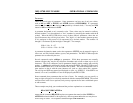
MFJ-1278B MULTI-MODE ADVANCED OPERATION
Here are a few simple suggestions for operating HF packet that should help to get you started.
1. Do NOT try to hold a QSO on one of the calling frequencies. Use the calling frequency
only to establish contact and then MOVE OFF TO A CLEAR FREQUENCY to carry
on the QSO. Remember to be aware of the frequencies your station is actually
transmitting so you can avoid interference to other services such as propagation beacons
etc.
2. Configure your station so that you can hear the activity on the channel. This will allow
you to easily avoid interfering with other stations and also to quickly diagnose the
problem when throughput suddenly falls off for some reason (usually propagation or
interference).
3. If possible, use the highest frequency band possible to communicate with any specific
station. The closer you are to the maximum usable frequency (MUF) the less
intersymbol interference you will have from multipath effects. If you have a schedule
with another station, arrange your times and frequencies accordingly.
4. Set the following parameters off unless you have some specific reason for doing
otherwise:
DIGIPEAT OFF**There is NO reason good enough to enable this function on HF.
DWAIT 0 OFF
AX25V2 OFF
CHECK 0 OFF
CMSG OFF
RETRY 0**Try forever, but NOT if unattended operation. This allows YOU to be
the one to decide when or whether to give up rather than the MFJ-1278B. Typically you
know more than the MFJ-1278B does about whether the other station is still trying or is likely
to recover from the latest fade.)
MAXFRAME 1**Multiple frames OFF.
RESPTIME 0**Some stations may have trouble copying your ACKnowledgments
(ACKs) when you respond this fast. This is due to the fact that some radios pump up the
AGC voltage during transmit and if the AGC time constant is long, they are essentially deaf
for a while after transmitting. You will want to experiment with this value. In general, you


















